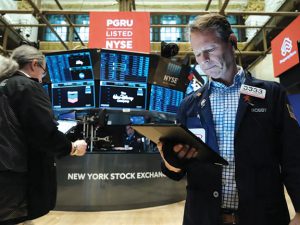Bloomberg
Investors fled every major asset class in the past week, with US equities and Treasuries a rare exception to the massive exodus, amid concerns that tightening monetary policy will push major economies into a recession.
Equity funds had $5.2 billion outflows in the week to May 18, led by redemptions from mutual funds, according to Bank of America Corp’s note citing EPFR Global data. Bond fund outflows reached $12.3 billion, with only Treasuries and government debt seeing additions. Investors also exited cash and gold.
Global stocks have lost nearly $12 trillion in market value since their peak in March as investors fled risk assets amid a flurry of concerns spanning hawkish central banks and surging inflation. Although strategists ranging from David J. Kostin at Goldman Sachs Group Inc. to Marko Kolanovic at JPMorgan Chase & Co. have said fears of an imminent recession are overblown, strategists broadly agree that the equity market rout has further to go.
While BofA’s custom Bull & Bear indicator tumbled to an “unambiguous†contrarian buy signal for stocks, strategists led by Michael Hartnett reiterated their recommendation to sell any bear rallies. The S&P 500 attempted to stage a recovery over the past week, however, the bounce proved short-lived and the benchmark is set for its seventh week of declines in the longest losing streak since 2001.
Hartnett said that in 19 US equity bear markets over the past 140 years, the S&P 500 saw an average decline of 37.3% with an average duration of 289 days. If repeated, BofA said the latest bear market would end in October, with the S&P 500 at 3,000 points — about 23% below current levels, and the Nasdaq at 10,000 points —16% lower from here.
Among equity funds in the past week, US stocks saw $0.3 billion inflows, followed by additions to Japanese shares, while European stocks extended their outflows to a fourteenth week. Investors piled into US large-caps and growth stocks, while exiting value and small-caps. Among sectors, utilities and real estate led the inflows, while financials, materials and energy saw outflows.
Futures rise with stocks as China lifts sentiment
US equity futures pushed higher on Friday along with stocks in Europe after China’s latest measure to bolster its economy injected a note of optimism at end of another volatile week for global markets.
Futures on the S&P 500 and Nasdaq 100 rose more than 1%, shrugging off modest losses on Wall Street. Treasury yields edged higher, and the dollar was steady after its biggest one-day drop since 2020. Oil held above $111 a barrel.
The Stoxx Europe 600 index added 1.5%, erasing the week’s losses. Carmakers led the advance, rebounding after two days of declines. Basic resources outperformed as industrial metals rallied. Consumer products was the only sector in the red as Richemont slumped after the Swiss watch and jewelry maker forecast rocky times ahead.
Chinese lenders lowered the five-year loan prime rate by a record amount in an effort to boost mortgages and loans amid a property slump and Covid-19 lockdowns. The move “is without doubt a positive in terms of raising the market’s sentiment,†said Niu Chunbao,
a fund manager at Shanghai Wanji Asset Management.
Rebounds in risk sentiment have tended to fizzle this year. Investors continue to grapple with concerns about an economic downturn, in part as the Federal Reserve hikes interest rates to quell price pressures. Global shares are on course for an historic seventh week of
declines.
Traders in the US will be bracing for more volatility due to the monthly expiration of
options tied to equities and
exchange-traded funds. The process is notorious for stirring up market swings.
 The Gulf Time Newspaper One of the finest business newspapers in the UAE brought to you by our professional writers and editors.
The Gulf Time Newspaper One of the finest business newspapers in the UAE brought to you by our professional writers and editors.
